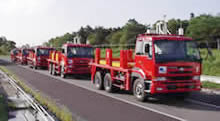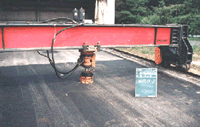| HOME | Study themes | Research Facilities | Members | Papers | Links | Japanese Page | Public Works Research Institute |
| Pavement Research Team HomePage |
| HOME > Research Facilities and Test Equipment |
| Research Facilities and Test Equipment |
| Pavement Test Field | Heavily Loaded Vehicles Movie (Windows Media / 278KB) |
|
The performance of pavement gradually deteriorates due to repeated traffic load. Before applying unproven new pavement technologies to general roadways, evaluations must be performed in advance, including experiments both in the laboratory and with full-scale test pavement subjected to actual-scale traffic loads. On the Pavement Test Field, traffic load equivalent to that acting on a general roadway during a decade (with a design traffic volume of 1,000 to less than 3,000 vehicle passages per day per direction (equivalent to former Traffic Category C)) can be reproduced in 2,000 hours at the shortest by continuously operating four heavily loaded vehicles on the test pavement at the same time.
|
 Presently, the Pavement Research Team owns five heavily loaded vehicles. These large trucks have a maximum weight of 392 kN (40 tons) and are designed for use in accelerated loading tests for pavement. Up to four of them can be operated simultaneously at 40 km/h by unmanned operation assisted by a system combining an RTK-GPS and an optical fiber gyro using at least four satellites. A commercially available truck model with one front axle and two rear axles (double tires), which is the most common type in Japan, was modified for heavy loads by installing a loading platform. The rear axle weight can be changed in increments of 19.6 kN (2 tons) from 34.3 kN X 2 axles (3.5 tons X 2 axles without any loading plates) up to 156.8 kN X 2 axles (16 tons X 2 axles with 14 loading plates). Presently, the Pavement Research Team owns five heavily loaded vehicles. These large trucks have a maximum weight of 392 kN (40 tons) and are designed for use in accelerated loading tests for pavement. Up to four of them can be operated simultaneously at 40 km/h by unmanned operation assisted by a system combining an RTK-GPS and an optical fiber gyro using at least four satellites. A commercially available truck model with one front axle and two rear axles (double tires), which is the most common type in Japan, was modified for heavy loads by installing a loading platform. The rear axle weight can be changed in increments of 19.6 kN (2 tons) from 34.3 kN X 2 axles (3.5 tons X 2 axles without any loading plates) up to 156.8 kN X 2 axles (16 tons X 2 axles with 14 loading plates).
|
| Research Facility for Paved Road Surface Noise | ||||
| The Research Facility for Paved Road Surface Noise is designed for conducting research on both low-noise pavement and the noise generated by the contact of tires with the road surface due to vehicle passage, as well as for assessing the devices used to measure tire/road surface noise. This facility has a test pavement section comprising four types of paved road surface (dense-graded pavement, drainage pavement (5) (maximum particle size of 5 mm), drainage pavement (13) (maximum particle size of 13 mm), and porous elastic pavement), where noise can be measured and evaluated by vehicles traveling at 40 to 60 km/h. The respective types of paved road surface are 3 m in width and 80 m in length, with an acceleration path and a deceleration path on either end of the test pavement section. Each test pavement consists of the surface course, binder course, base course, and subbase course. To maintain the intended road surface properties constant, the test pavement section is covered with a tent for protection when not in use. When conducting noise measurements, the air temperature at the facility and the driving speed of vehicles on each paved road surface can be automatically measured.
|
||||
| FWD Checkup Facility | ||
| The FWD Checkup Facility is used for calibrating and checking displacement meters and load meters which are the major measuring devices of the falling weight deflectometer (FWD). The building is approximately 14.5 m long, 5.5 m wide, and 5.5 m high, and contains asphalt pavement and concrete pavement for calibrating and checking the displacement meters, as well as concrete pavement for calibrating and checking load meters. The building is air-conditioned to keep the temperature at around 20oC. The use of calibrated and checked FWDs allows uniform evaluation of the structural bearing capacity of pavement throughout the nation without data variations caused by different models of measuring equipment.
|
| Cyclic Loading Equipment | FWD |
 The Cyclic Loading Equipment is used for observing the behavior and fatigue properties of pavement under static and dynamic loading conditions, which are created by iteratively loading the test pavement prepared in a concrete pit measuring 5 m in width and 15 m in length. The Cyclic Loading Equipment is used for observing the behavior and fatigue properties of pavement under static and dynamic loading conditions, which are created by iteratively loading the test pavement prepared in a concrete pit measuring 5 m in width and 15 m in length. Using a piston actuator equipped with a loading plate of 300 mm in diameter, this equipment can apply both static and dynamic loads to the test pavement. With a loading frame installed on rails, the loading positions can be freely selected by moving the equipment back and forth and around. The equipment can apply static loads of up to 147 kN when conducting static loading, as well as dynamic loads of up to 147 kN in the frequency range between 0.2 and 2 Hz when conducting dynamic loading. |
 The falling weight deflectometer (FWD) is used for measuring road surface deflection. A weight is dropped onto a circular loading plate placed on the paved road surface to generate road surface deflection, which is measured by simultaneously using multiple sensors, and then deflection curves of the road surface are obtained. A cargo van was modified and equipped with measuring devices for use as the FWD carrier, which can be driven to the intended points where measurements are to be conducted by placing a loading plate and sensors on the road surface. . The falling weight deflectometer (FWD) is used for measuring road surface deflection. A weight is dropped onto a circular loading plate placed on the paved road surface to generate road surface deflection, which is measured by simultaneously using multiple sensors, and then deflection curves of the road surface are obtained. A cargo van was modified and equipped with measuring devices for use as the FWD carrier, which can be driven to the intended points where measurements are to be conducted by placing a loading plate and sensors on the road surface. . As deflection measured by FWDs is generally known to be correlated to the bearing capacity of pavement, the FWD is used for evaluating the structure of and selecting the method for repairing existing pavements. |
| Wheel Tracking Tester |
|
| Road Technology
Research Group Pavement Research Team Copyright (c) (2008) by PWRI |